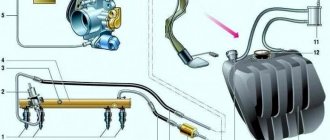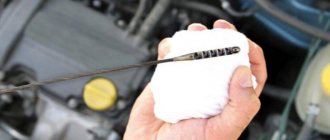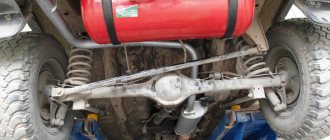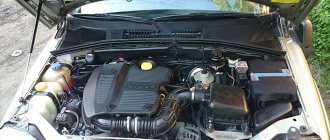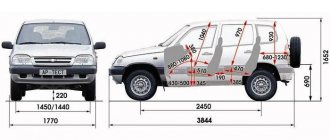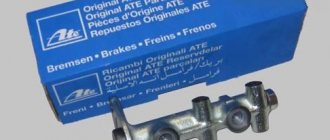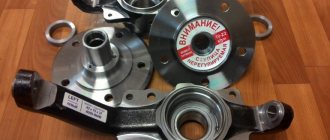Diagnosing problems on cars - what to pay attention to?
Diagnosis of a malfunction consists of checking the condition of all components that were discussed above and replacing faulty elements.
In this case, everything begins with a visual inspection, after which it is worth moving on to checking individual components - the fuel filter, carburetor, injector and others.
It is also worth considering that cars with a carburetor and an injector have their own nuances of searching for damage:
Carburetor cars VAZ 2101-2105/2106/2107.
As mentioned above, the weak point of the “classic” is the carburetor, the operation of which is based on a mechanical principle.
To avoid problems, it is recommended to periodically adjust the device and check it for serviceability.
In case of unprofessional adjustment, fuel overflows from the top, and its vapor enters the vehicle interior.
In injection cars, the problem of overflow is eliminated.
Diagnosing the problem is easy. When the engine is idling, the carburetor is dry and clearly performs its functions. But as soon as you add gas, fuel flows out from under the membrane.
The reason is broken threads or poorly tightened bolts. There are situations when the carburetor leaks the intake pipe to which the supply hose is attached.
Also, on the “classic” there are often problems with the fuel pump, from under the membranes of which fuel leaks. To eliminate the problem, it is worth tightening all the bolts.
Injection cars.
This category includes the currently popular Lanos, VAZ-2107, 2108, 2109, Niva (21213) and other models (including 2110, 21099).
In such cars, there may be a problem with the injector nozzle, which breaks off if there is a defect or improper use.
Problems often arise in the fuel line - in the area from the tank to the engine. For this reason, the first thing to start with is to inspect the fuel line. Once a leak is discovered, it should be repaired immediately.
Features of the transition to HBO
- Gas equipment (LPG) is installed on the Niva in the same way as on other vehicles.
- When installing gas, it is necessary to determine a place for the cylinder (in the trunk (90 l), along the trunk (50 l), under the bottom).
- The risks of smoking indoors are the same as those of gasoline.
- Choosing an LPG system for Niva: ejector or injection.
- The technical condition of a car with LPG must be constantly monitored.
- If you smell gas, fix the leak.
- Drain condensate from the gearbox (with an ejector system).
- It is advisable to set the ignition 5 degrees in advance.
- At temperatures below +10, the car will start only on gasoline.
- The Niva takes a long time to warm up in the morning if you install HBO.
We identify Niva problems “by smell”
Some of Niva's problems are literally under our noses. You can detect them by smell:
• Smell like burnt bread (light, pungent odor) - often indicates an electrical short or burning insulation. To be on the safe side, try not to start the car until the problem has been diagnosed.
• Rotten egg smell (a persistent smell of burning sulfur) - usually indicates a problem with your Niva's catalytic converter or other emissions control devices. Don't delay diagnostics and repairs.
• A strong pungent odor usually means burning oil. Look for a sign of oil leakage or heating.
• The smell of gasoline vapor after an unsuccessful start means that the Niva’s engine is flooded. Wait a few minutes before driving again. If the smell persists, there is likely a leak in the fuel system - this is a potentially dangerous problem that requires immediate attention.
Also interesting: Disabling the front axle of a Niva 4x4 (reviews, pros and cons) » Lada.Online
• Burning tar or a pungent chemical smell may indicate that the brakes or clutch are overheating. Check the Niva's parking brake - believe me, it's worth stopping for this. Allow the brakes to cool after repeated heavy braking on mountain roads. Light smoke coming from the wheel indicates a stuck brake. The vehicle must be towed for repairs.
• A slight evaporating odor indicates a coolant leak.
If the temperature indicator or warning light does not indicate overheating, carefully drive the vehicle to the nearest service station, keeping an eye on the Niva's sensors. If the smell is accompanied by a hot metallic smell and steam coming from under the hood, the engine is overheated.
Stop immediately. Continuing to drive may cause serious damage to the engine.
Features of the conversion of a Niva with an injector
When installing LPG on Niva 21214, you can pay attention to the Gromyko Gas Injector (GIG) from a Russian manufacturer for cars with single injection.
Equipment from Italian or Polish manufacturers is more expensive.
For an injection car, the best choice is the 4th generation. Here are the following nuances:
- The place for the donut-shaped cylinder can be determined in the trunk by removing the spare tire. The cylinder is placed under the bottom. Plus, you don’t need to touch the spare wheel. The gas tank filling valve should be located near the filler neck. In Niva 4x4 pickup 2329 the gas tank will fit in the cargo compartment. This model can also accommodate heavy methane equipment.
- Be sure to redo the muffler and tow bar. When transferred, the muffler is digested in such a way that it bends around the gas cylinder. The parts can be connected using couplings. You can modify the old towbar or buy a suitable modification from the factory.
- The gas ramp is installed above the manifold.
- It is necessary to lay a line to supply the gas mixture from the reducer and install a filter.
- Gas lines are tied to gasoline lines.
- After installing the gearbox, connections are made to the car's standard cooling system.
On a note! When modifying a factory muffler, you need to take into account that a makeshift installation of an exhaust system is illegal. Therefore, it is better to purchase a ready-made option that is suitable in shape.
Gas equipment for cars, of a more modern design, is already equipped with an electronic control unit, which is equipped with a program that even takes into account road conditions and the type of injection.
When setting up the system, the performance of an internal combustion engine on gas fuel is compared to the performance of a power plant on gasoline. The settings for VAZ 21310, 21213 and 21214 are different. Debugging of the gas system is done only under service conditions.
Chevrolet Niva (2009+). The smell of gasoline in the cabin, reasons
content .. 99 100 101 102 ..
- Chevrolet Niva (2009+). The smell of gasoline in the cabin, reasons
- Causes
- Malfunction of the fuel pump
or rupture of its sealing elements (gaskets);
Scuffs and holes in the gas tank
. It is necessary to check the reliability of its fastening. If it rubs against the body parts of the car, over time holes will appear in it, through which the smell of gasoline will escape and enter the cabin. In such a situation, it is necessary to repair the gas tank;
- Depressurization of the fuel tank cap
; - Problem with fuel hoses
: poor tightening or cracks; - Dirty fuel filter
. If this is the problem, it needs to be replaced; - The spark plugs are poorly tightened
or have carbon deposits on them;
The tank fell off its mounts
. If the tank falls off, it will rub against the body of the car. Over time, a hole will form on it through which gasoline will flow. The tank can be repaired at a service station.
Tank cap malfunction
. The fuel tank is equipped with a sealed cap that prevents leakage. However, over time it may break and then need to be replaced. The gas tank cap does not close the filler neck tightly.
To solve the problem, you need to disassemble the rear part of the cabin and, by pulling off the plastic trim, slightly loosen the clamps. After this, screw the fuel tank cap tightly and tighten the clamps again tightly. Then it will take the correct position, tightly closing the neck. The fuel pump gasket is leaking fuel.
The fuel pump is located under the rear seat. If the gasket is damaged, it must be replaced with a new one.
Fuel hoses are incorrectly secured or frayed
. In such cases, fuel begins to flow through the clamps. They must either be replaced or tightened to the required standard.
The fuel pump is not working well
. The operation of the unit may be difficult due to contamination or damage. In a carburetor car, the fuel pump can leak if the membrane breaks.
Fuel filter clogged
. If this problem occurs, you just need to clean the fuel filter or replace it.
Incorrect carburetor setting
. In this case, excessive fuel consumption occurs. Excess gasoline leaks out and gives off a characteristic odor.
External factors
. The smell of fuel may come from an old domestic car that is driving in front of you. Your car's air intake system sucks in this air, causing the smell to spread throughout the cabin. To combat this, you need to turn on air recirculation.
Gas tank perforation
. May occur due to a weld defect. It can be eliminated using “cold welding”.
The problem may also be the presence of multiple holes formed as a result of the development of corrosion processes.
The adsorber is clogged
. This device is installed in the rear wheel arch and is designed to collect gasoline vapors. During operation, the adsorber becomes clogged and must be periodically cleaned and replaced.
Door seal wear
. This is the rarest and most specific reason for the appearance of a fuel smell in the cabin. The fact is that the fuel tank filler flap is located near the edge of the right door. When the seal wears out, gasoline vapors enter the vehicle interior. The way out of this situation is to replace the seal.
Loosely twisted candles
. It is necessary to tighten them properly, and if they break, replace them.
Listed above are the most common reasons why the smell of gasoline appears in the car interior. There are also more specific situations, for example, the problem may be related to the car door trim, near which the gas tank is located. If the trim or seal in the car door has become unusable, odors from the fuel tank hatch will be heard in the cabin.
The easiest way to determine the reason why the car smells like gasoline is at a service station. Specialists can check the car using diagnostic equipment, and if no errors are found, it will be possible to rule out problems with the engine, fuel system and other units and start looking for an easier cause to eliminate.
content .. 99 100 101 102 ..
Niva - Club / Niva - Club
In mine, the upper fitting along the lower contour was not welded. The right photo shows that its welding disk even shines - it did not melt during welding. Although there is a weld on the top of the vessel. The third most common reason is that there is a smell of gasoline in the interior of the Chevrolet Niva, why are there thin separator hoses. There have been cases where these nipples simply broke off - then they can be repaired by “cold welding”.
But more often the smell occurs as usual due to poorly tightened clamps.
To access the nipples, you need to remove the plate covering the gas tank, also see. On carburetor cars, these thin hoses can be pinched because they are passed between the front wall of the gas tank and the partition on the bottom of the body. You need to loosen the screws securing the front of the gas tank and straighten the thin hoses. There have been cases of odor appearing due to the fact that the gas tank cap, resting its edges against the rubber frame of the neck, did not tightly close the neck hole.
The following treatment method is recommended: The gas tank plug will take the correct position and close the neck with its rubber insert.
The rarest case is perforation of the gas tank. I remember only two such messages in the conference.
One time the cause was a defective weld. It can simply be sealed with “cold welding”. In another case reported, there were multiple holes, apparently caused by corrosion.
Of course, such a tank simply needs to be changed: The author of the message repaired the tank by irradiating the defective area and filling it with a layer of solder. Individual “bursts” of the smell of gasoline, felt when there is a smell of gasoline in the interior of a Chevrolet Niva why car, on my first Nivka were a sign of a leaky gasket under the electromagnetic valve of the EPH system. If at the same time there were problems with idling, there was a smell of gasoline in the interior of the Chevrolet Niva, why, without even opening the hood, I knew that again it was time to change this gasket in the Solex, “restored” at MOSKARZ, this establishment would not be remembered by night!
In long Niva, a specific reason for the appearance of the smell was described in the conference. Due to the fact that the gas tank filler flap is located at the very edge of the right rear door, gasoline vapors were drawn into the cabin through the worn door seal.
This will most likely need to be treated by replacing the seal. Addition from Two more rare cases are described in the forum. There is another reason for the smell of gasoline in the cabin. The carburetor return hose from the carburetor was leaky, and it dripped sporadically, and the stench apparently was drawn in through leaks in the ventilation.
I discovered it by accident - while adjusting the valves. Snickers original: The smell of gasoline was terrible in the cabin. The hole is sealed. The smell has been eliminated.
The smell appeared only when the tank was half empty: After a long search, a strong leak was discovered along the fuel pump studs - up to bubbles when the car was rocked.
The dark spot around the fuel pump in the right photo is spilled gasoline: For repairs, you need a sealant specifically designed for repairing gasoline pipelines and does not contain silicone. Silicone is dangerous for injection cars - it damages the lambda probe.
A suitable sealant was purchased for RUR. The consistency of the sealant resembles transmission oil. The application brush is attached to the lid, which is very convenient.
The rear part of the cabin needs to be disassembled, as described in the articles Adjusting the VAZ fuel level gauge or Modifying the drainage of the VAZ gas tank If the tank is full, drain liters of gasoline from the tank in advance: You need to remove the plate covering the gas tank through the hatch in the gas tank plate, do not remove the connector, unscrew the 8 nuts key 7, be sure to uncouple the fuel pump hoses with two keys 17 and remove the fuel pump: You need to apply a sealant to the surface of the gas tank at the place where the fuel pump is installed, especially in places where it smells like gasoline in the interior of a Chevrolet Niva, why the studs and the studs themselves, then the gasket on both sides and the bottom surface of the fuel pump: Install the fuel pump into place, tighten the nuts “crosswise” in two steps:
There is a smell of gasoline in the car: reasons
So, let us immediately note that the smell of gasoline in a car may not appear all the time, but only under certain conditions. For example, in severe frosts or heat, when a cold engine is just starting or after the power unit has warmed up, when filling a full gas tank, etc.
In any case, it is necessary to establish the reason why the odor occurs. Note that in some cases it is quite difficult to quickly solve the problem. It is necessary to check the elements of the fuel system step by step.
First of all, you need to start diagnosing with the gas tank and its cap. The tank, especially on older cars, can rot. The tank mounts also suffer, as a result of which it begins to shift. Also, over time, welds, etc., become unusable.
The possibility of mechanical damage should also not be excluded. One way or another, even a minor leak will mean that fuel leaks out, filling the car interior with fumes, etc.
The cap, which is screwed into the filler neck, also deserves special attention. In many cases, this area is the source of the gasoline smell. The fact is that the lid not only tightly closes the tank, but also has an additional valve.
This valve is needed to avoid an increase in pressure in the tank during temperature fluctuations and expansion of gasoline with heating. If the valve is clogged or stuck, or there are problems with the sealing gasket of the cap, then a distinct smell of gasoline will appear.
Let's move on. If everything is normal with the tank, then you need to inspect the fuel line, connections and clamps, and also check the integrity of the pipes. Along this line, gasoline is both supplied to the internal combustion engine (supply) and its excess is returned back to the tank (return).
Hoses may begin to leak, and the reliability of their fastenings will deteriorate. It is quite obvious that in this case a leak also occurs, and gasoline fumes will annoy the driver with the smell of fuel in the cabin.
The next element to check is the fuel pump. On cars with a carburetor, the fuel pump is often located under the hood or outside the tank. At the same time, on injection cars, the fuel pump is submersible (located in gasoline to extract fuel and cool), that is, it is actually “screwed” into the gas tank. As a rule, on many cars with an injector, the pump is located under the rear seat right inside the vehicle.
If problems with the gasket appear at the installation site of the electric pump, the thread of the cover is cracked or damaged, etc., then a persistent smell of evaporating gasoline appears in the cabin.
Fuel filters, especially if they are dirty and have reduced capacity, can also cause the smell of gasoline in the car. The reason is an increase in pressure in the fuel line, after which the joints of the pipes begin to leak; gasoline can flow at the “input” before or at the “outlet” after the filter itself.
To eliminate this cause, the fuel filter needs to be changed, and as part of further operation, select the correct element for a specific car and replace the filter according to the regulations, avoiding severe contamination of the filter element.
The power supply system with a carburetor requires a separate check of this fuel supply system to the engine. Often, the carburetor requires adjustment, and its incorrect adjustment or malfunction of the device leads to gasoline overflowing.
Naturally, active evaporation of fuel in the engine compartment will cause gasoline vapors to enter the cabin. To prevent this from happening, it is necessary to properly adjust the fuel level in the float chamber, check the condition of the jets, regularly clean the carburetor, etc.
https://youtube.com/watch?v=osu_5loYA0w
Main reasons
In no case can we say that the interior of only certain cars stinks of gasoline, such as Lanos, Lada Priora, VAZ, Hyundai Accent or Chevrolet Niva.
This problem is typical for all types of vehicles, regardless of make, model, year of manufacture and other factors.
It is unlikely that anyone will be happy with the fact that when you start the engine or just get into the cabin, a characteristic smell of fuel is heard inside.
This usually happens due to:
- gas tank leaks;
- leakage of tightness;
- problems in the output system;
- faults in the fuel line;
- spills, etc.
Now we will separately consider common situations that can cause the cabin to stink. And also ways to solve them.
Spilled gasoline
The most banal and quite common situation. A motorist, having bought a 20-liter gasoline can, filled it with fuel and put it in the trunk.
Either the lid was not screwed on, or the container itself was faulty or defective, which is why fuel gradually began to spill out of it. As a result, fumes and odors penetrated into the cabin.
There is no need to invent anything special here. Just remove the source of the leak from the car, clean up the spilled fuel, and that's it.
Traffic fumes
If the smell appeared when a window or door was open and the car was started, there is a possibility that the smell is caused by exhaust gas aromas entering the cabin.
In general, the very fact that the exhaust smells of gasoline is not very pleasant. This indicates incomplete combustion of the fuel. And here the reason may lie in an incorrectly configured carburetor, problems with the injector control unit, oxygen sensor and many other components.
Therefore, a comprehensive diagnosis will be required here. Only if you are not sure exactly why the fuel does not burn completely, and this manifests itself in the form of a characteristic smell of gasoline from the exhaust pipe.
We determine the problem by general sensations
Heavy handling, rough ride, vibration and poor performance are symptoms you may feel. They almost always point to Niva's problems.
Steering problems
Damaged front wheels and/or worn steering components such as the ball joint or ball joint can cause the steering to wander or become difficult to steer in a straight line.
Traction - the tendency of the car to steer to the left or right is caused by something ordinary, for example, when the tires are insufficiently inflated or due to a more serious malfunction - a violation of the geometry of the Niva's body.
Suspension problems
Worn shock absorbers or other suspension components can contribute to poor cornering.
While there's no hard and fast rule about when to replace your Niva's shock absorbers or struts, try this test: Lift the car up and down hard on each wheel, then release. See how many times the car bounces. Weak impacts will allow the car to bounce twice or more.
Springs usually do not wear out and do not need to be replaced unless one corner of the vehicle is lower than the others. Overloading your vehicle can damage the springs.
Balance your tires properly. An unbalanced or improperly balanced tire causes vehicle vibration and premature wear of steering and suspension components.
Brake problems
SUV brake problems have several symptoms. It is worth contacting a service workshop if the vehicle pulls to one side when using the brakes. Or the brake pedal drops to the floor when pressure is maintained. It happens that while braking you hear and feel scratching or grinding. This is also a sign that something is wrong with the brake discs. If the “Brake” indicator on the instrument panel is on, then this also indicates problems with the Niva’s brakes.
Engine problems
The following faults indicate engine trouble: difficulty starting, check engine light on the dashboard, rough idling or stalling, poor acceleration, poor fuel economy, excessive oil use.
Other Niva problems may also appear, for example, when the engine continues to run after the key is removed.
Transmission problems
Poor transmission performance can be caused by actual component failure, a simple disconnected hose, or a clogged filter. Repairing a Niva gearbox is usually expensive, so don’t delay the repair.
Also interesting: Rear disc brakes on Niva 2121 instead of standard drum brakes || Strengthened brakes on a Chevrolet Niva
Some of the most common symptoms of manual transmission problems include sudden or harsh shifts between gears. Delay or lack of response when moving from neutral to drive or vice versa. Inability to shift during normal acceleration. Slipping during acceleration. The engine accelerates, but the car does not respond.
Does the result justify the cost?
Of course, the decision to switch to gas entails some difficulties and has a number of disadvantages.
This includes a lot of modifications, an increase in the weight of the car, and problems with installing a cylinder, where you definitely need to sacrifice something. In addition, you will have to pay for everything. However, the advantages of the decision to switch to gas are many times greater. Especially if the system is installed and configured correctly. As a result, you will get an economical car that will run much quieter and will hardly pollute the environment. Moreover, such a solution will extend the operation of the engine, increasing its service life. But the main thing for every motorist is saving on fuel, since gas is cheaper than gasoline.
Handout pillows.
In this new detail, we are completely on the side of the AvtoTAZ designers. A detail that can truly be called tuning. There is a lot of “rubber meat” and the design already works completely differently. We recommend replacing the old-style transfer case cushions with new-style ones as soon as possible. On many sites dedicated to the Niva, these pillows are advertised as spare parts for the Niva-Urban, and they ask for a lot of money. Meanwhile, this part is simply installed on the M-ki. Catalog number 21214-1801012-02.
An example from history. The reliability of Mercedes suspensions has already gone down in history and legend. We are not talking about modern multi-links, which have 20 parts, we are talking about cars produced in the 90s. The secret is simple, almost all silent blocks and pillows were the size of a fist, which is why they cost 300-500 thousand.
How to remake a towbar and muffler.
Installing LPG on a Chevrolet Niva will invariably require changes to these devices. The most successful solution would be to use a tow bar from Bertone. It should then be modified so that:
Remaking the muffler consists of installing a system with two modules, one of which will have a bend in order to bypass the cylinder.
But before you independently install LPG on a Chevrolet Niva, you should remember that this is a rather dangerous procedure, the violation of technological processes of which can lead to unpredictable consequences.
In conclusion, it is worth noting that it is better to carry out the work at a service station in order to fully comply with the technological process and be able to check the functionality of the system using special equipment.
Chevrolet Niva Shniva › Logbook › The smell of gasoline in the cabin
A persistent smell of gasoline appeared in the cabin. At first the smell was not strong and not always. I attributed this to fuel splashing through the filler plug, just like on a regular Niva. But no, the neck and wing outside were dry. Which means the reason is somewhere in the cabin.
I was thinking about the fuel pump module or the connection between the neck and the tank.
As time passed, the smell became sharper and stronger. It got to the point where it stopped weathering.
In addition, it got warmer outside to +16 +20 and it became simply unbearable to be in the cabin.
I emptied the trunk into the garage. I removed the seat backs and soundproofing mat, unscrewed the gas tank flap, and removed the cross member securing the tank. And most importantly, it was necessary to remove the wing trim, the one in the trunk, it is large and shapeless.
There were traces of gasoline on the tank flange under the neck.
I drove like this all day and this trail periodically turned into a puddle.
It was interesting that the joint between the neck and the tank was coated with sealant. Apparently the previous owner already encountered the problem.
I thought for a long time about how to fix it, whether to cover it with sealant, or try to tin it with solder, or even remove it and weld it.
But first, it was necessary to find the crack along its entire length, and for this it was necessary to clean the entire joint.
I did this with fine sandpaper and it turned out very well.
A crack appeared and began to sweat, while the tank was almost empty, and if you tumble into a left turn, the puddle appears again.
The sealant chosen was Victor reinz, the price per tube was 550 rubles, it used to be expensive, but now every multi-colored Abro costs almost the same...
After removing dirt from the surface and degreasing, I applied sealant and let it dry a little.
After the repair, I drove 400 kilometers and managed to refuel a couple of times. Nothing will happen, no sweating and no smell.
Source
Write a review
The filling valve is located next to the filler neck for filling gasoline. To supply the mixture to the engine, brass lines are laid. They lead from the cylinder to the engine compartment.
It is recommended to install near the gas pipeline. It is better to locate the system gearbox on the left side of the engine compartment.
It should not be attached to the engine to avoid overheating. You can, of course, leave it like that, the exhaust will be under the other. Of course, there are advantages to this option, namely, it is a minimum of time and money spent when replacing the muffler again, but there are also disadvantages, since such a design will affect the cross-country ability, the muffler outlet will look down like a hook Well, you need to add extra.
With this option, you can try to use a Moskvich muffler and it will blow right under the bottom in the RZM area. In general, the creative vein is in full swing and I moved on.
I decided to move the exhaust aft to the starboard side.
This is the most difficult section, remaking the gander across the bridge. I brought it out between the panhard mount and the rear brake pressure regulator, but this is still a test version.
ITALGAZ Volga region. Silencers for Niva.GBO Tolyatti
Again, we adjust everything directly on the machine and only then scald it. We extend the hook of the fastening to the elastic band and attach it to its regular place.
With this option, it will not be possible to change the muffler without welding. This is what the final version looks like. The only jamb is that the handbrake cable is touching... While we were leaving the GSK “builder”, there are now potholes there and the suspension moves are good, nothing rattled anywhere from below.
- Go to page:
Questions about HBO
Post by Bladerunner » Apr 08, 2010 5:47 pm
Connecting front-wheel drive in a Niva is not so much a technical question as it is a philosophical one. (c) Vovchik
Re: Questions about HBO
Post by medvedka » Apr 14, 2010, 05:40 pm
As the gas workers explained to me, nothing should happen from this. But that’s precisely why they ask about my experience in operating the TOR. I can’t imagine where else to put the gas... it will get in the way everywhere. According to NAMI requirements, it is prohibited to install it under the hood. And this definitely makes sense. But at the back, I don’t know. Who will say what?
Bladerunner: about the torus in the back, I thought, in principle, gas is dangerous only in a closed volume, i.e., let’s say, if it accumulates in the cabin, then oh! - it won’t seem like much, but from the street - it doesn’t matter. Why do all the gas lines in the house come from the outside - it’s easier to maintain and if there is a leak, nothing will happen.
That's how I think. There's an overpressure valve there, right? That is, if you hit it with, say, a sledgehammer, what will happen? If he hesitates, the pressure will rise. so what? It has been calculated with reserve. In general, you need to listen to experience.
The smell of exhaust gases and burning in the cabin
When the car is not completely new, and especially domestically produced, it happens that the smell of exhaust gases begins to be felt in the cabin. As a rule, this happens when the engine begins to eat up oil, and it is the product of its breakdown that gives this effect.
Oil scraper rings and caps no longer hold oil, a lot of friction and overheating arise between the bearings and fingers, which can burn the oil, and the oil pressure drops.
Definitely requires diagnostics of the exhaust system and the engine itself. You can figure it out on your own, but most likely it will not give a long-term effect. It is still safer to turn to professionals.
Gas equipment adjustment
There are quite a few ways to debug HBO, but most of them include the following aspects:
- Compliance of LPG with vehicle standard. Gas equipment on cars with EURO-1,2,3 environmental standards can use any control unit. For the Russian automobile market, the production of such vehicles ended in 2011. The only additional condition for reliable operation of the VAZ-2106, 2110, 21213, 21214 brands can be the use of high-quality radio components. And for models with the EURO-4.5 standard (VAZ-2131, 2123, 2121 and Largus after 2011), it must be equipped with a special program that takes into account road conditions and the fuel used.
- Settings options. When entering data, a difficulty arises with the type of fuel injection of a particular car brand.
VAZ-2131 belongs to cars with pairwise parallel fuel injection
Thus, vehicles with sequential fuel injection include VAZ-21213, 21214, 2123, 2110, 2106, 2121, Largus and Chevrolet, and vehicles with pairwise parallel injection include VAZ-2131.
We identify problems by ear
Squeaks, squeals, rumbles, rustling and other sounds provide valuable information about Niva problems and maintenance needs. Here are some common noises and what they mean:
• Squealing is a high-pitched, sharp noise usually associated with engine speed. This indicates a weak or worn power steering, fan or air conditioning unit.
• Clicking is a slight sharp noise associated with either engine speed or vehicle speed. There are several options: a slightly detached wheel cap, a bent fan blade touching the radiator, a valve stuck somewhere, or a low engine oil level in the Niva.
• A squeak is a high-pitched, high-pitched metallic sound that usually occurs while a vehicle is moving. This may be caused by worn brakes. Check if it's probably time for service?
• Rumble is a low rhythmic sound. This means the vehicle has a defective exhaust pipe, converter or muffler, worn universal joint or other drive line component.
• Whistling is a high-pitched metallic sound associated with engine speed. This is usually caused by using gas with a lower octane rating than recommended. Check the correct octane rating in the owner's manual. If the problem persists, an error may occur in the ignition of the Niva engine.
• Heavy beats - rhythmic grinding sound. Most likely, it is a worn crankshaft or connecting rod bearings. Sometimes this is how an open transmission torque converter manifests itself.
• A quick clunking sound or an occasional clunking sound is a suspension problem: a loose shock absorber or other component. Perhaps the Niva's exhaust pipe or muffler is failing.
Also interesting: Chevrolet Niva pinouts. Wire diagrams || Niva Chevrolet power window button diagram
Operating principle of HBO
Before installing the fittings, the area is treated with a high-temperature sealant. This is the most difficult section, remaking the gander across the bridge. I brought it out between the panhard mount and the rear brake pressure regulator, but this is still a test version. Again, we adjust everything directly on the machine and only then scald it. We extend the hook of the fastening to the elastic band and attach it to its regular place.
With this option, it will not be possible to change the muffler without welding.
They are laid from the cylinder to the engine compartment. Proper fastening of the line is considered to be tying them to the gasoline pipeline. Installing the gearbox The gearbox can also be installed at the beginning of the work.
Muffler for HBO Niva Chevrolet
This article indicates such a sequence in order to understand the principle of operation of HBO. In the video, the installation process takes place at a service station, so the order is different. The gearbox is located on the left side of the engine compartment. It is attached to the car body, but not to the engine - pay special attention to this.
reworking the exhaust system in the field. Muffler.
The procedure is described in detail in the video. At the end, a high pressure line and a vacuum pipe are connected to the gearbox. The photo below shows the placement of the gearbox with connected lines. Gas train It is necessary to insert fittings on the intake manifold.
It is best to remove the collector and perform drilling work. Drilling must be carried out with particular precision so that the gas fittings coincide with the gasoline injectors, have an equal angle and are located close to each other.
The threads are cut on the drilled holes. The photo below shows the location of the drilling holes for the fittings. Before screwing in the fittings, be sure to lubricate their threads with a special high-temperature sealant. Next, the manifold is installed in place, and we proceed to install the gas train, which we fix in the upper part of the manifold. A distinctive feature of this gas equipment is the supply of gas to the cylinders in liquid form.
But high wear and tear and high cost for such equipment reduces demand.
The system allows you to use gas and gasoline fuel simultaneously or supply gas in the liquid phase. Such models wear out quickly and require high-quality gas and regular maintenance. Among devices operating on injectors, the Gromyko GIG Gas Injector is considered to be the most suitable for working in the field.
This system from Russian manufacturers is distinguished by the presence of one gas nozzle. Regulation, startup and shutdown of the system is carried out using specialized software. The advantage of GIG 3 DL, among other things, is that there is no need to install additional emulators. For new car models like Lada Largus, you can choose an acceptable option among imported analogues.
Why does Niva Chevrolet vibrate?
First, you need to make sure that the vibration of the car occurs in the transmission units, and not on the mount of the power unit. To do this, set the gearbox and transfer case levers to the neutral position, and the engine speed is brought to those at which vibration was detected. If vibration occurs again, the reason lies in the engine or gearbox mounts.
Rubber-metal products delaminate over time and lose their elastic properties. If the vibration disappears, then the intermediate shaft and driveshafts are suspect.
The condition of the intermediate shaft is assessed with direct transmission engaged (IV speed). The vibration transmitted to the car body comes from hinges, elastic couplings or flanges. To check the beating of the cardans, it is necessary to accelerate to the test speed, or even better, to a speed slightly higher than the one at which vibration of the Chevrolet Niva was detected. Then the gearbox and transfer case levers are moved to neutral, and the car starts to coast. Only the cardan shafts work. The problem has not been resolved - the shafts are definitely unbalanced.
The last reason for a car to shake while driving may be a misaligned transfer case. This especially happens after transmission repairs. You should immediately check the condition of the engine and gearbox mounting mounts. If the cushions are worn out, there is no point in centering the transfer case.
Pros and cons of switching to LPG on Niva
As with any modernization, the advantages and disadvantages of the future system should be taken into account. It is necessary to take into account the economic component, technical difficulties, and changes in the behavior of the car. As a rule, the main advantage of switching to LPG is significant savings on fuel.
But it’s worth switching to gas-cylinder equipment if the car is used actively (approx. 15 thousand km/year) and the engine consumes more than 6 liters. gasoline. Otherwise, the transition to HBO becomes doubtful. Since it will take a long time to pay for the reinstallation and purchasing equipment.
Pros:
- Saving on fuel.
- Less engine wear.
- Maintenance costs are reduced.
- Environmentally friendly fuel.
- The smoothness of the ride is improved.
- Acoustic comfort comes.
- The total mileage increases.
- Increases the service life of spark plugs.
- The engine runs smoother.
Minuses:
- Driving dynamics are slightly reduced.
- A decrease in power is felt.
- It is difficult to predict the fuel balance.
- In summer, the carburetor quickly becomes clogged.
- The load on the cylinder head increases (valves burn out).
Switching to LPG gives an excellent advantage when traveling long distances, as it gives the car enough additional power reserve. With this system, the car travels much longer distances. After all, you can drive part of the way on gas, and when it starts to run out, immediately switch to gasoline. This undoubted advantage will allow you not to refuel with questionable quality gasoline in remote areas throughout the entire journey.
Also, the ability to switch from gasoline to gas and vice versa allows the driver to choose the best mode for him. For example, on highways you can choose gasoline, but in a populated area switch the engine to gas (after all, the engine is already losing power).
ICE running on gas operates more stable and quieter than on gasoline. This is explained by the fact that the octane number of gas is approx. 110, which is higher than the octane number of gasoline.
Dish detergent
Gasoline is a chemical oily product. To remove fuel stains, you can try using dishwashing detergent on them. After all, such liquids have a special chemical composition that allows you to quickly break down fats. In addition, dishwashing detergent necessarily contains fragrances and fragrances that help get rid of unpleasant odors.
It is enough to pour a little liquid onto the fuel stain and wait until it is absorbed, and then carefully rinse with water. If the contamination is large, it must be removed in several approaches.
Advantages of gas equipment
When thinking about installing gas equipment in a field, you need to understand that such a choice has many advantages:
Installing LPG on a Chevrolet Niva will reduce the cost of refueling a car
Installing LPG on VAZ-2106, 2110, 2131, 2123, 2121, 21213, 21214, Chevrolet and Largus cars with 4th generation gearboxes will be an excellent solution for car owners. With proper installation and regular maintenance, the system will operate safely and last for many years.
Diagnostics
If the coolant leak is significant, the smell is accompanied by characteristic, wet spots under the heating system or pipes. In such a situation, identifying the malfunction will not be difficult. Additionally, rapid removal of antifreeze from the expansion tank will help. However, in the absence of physical traces, the procedure becomes a full-fledged quest. The liquid leaves in droplets, quickly evaporating, which makes it difficult to find a breakdown.
If the smell of antifreeze appears in the cabin when you turn on the heater, the search area is significantly narrowed. The reasons may be such factors.
- After replacing the radiator, the pipes are not securely fastened. Under weak clamps, when temperature and pressure increase, a gap may form. The breach allows antifreeze to leak out, where rapid evaporation occurs. Thus, there is a smell - there is no moisture.
- Defective or worn heater radiator. If a part develops a microcrack, locating the location is problematic. In this case, the liquid is released in minimal quantities, which makes it impossible to establish the breakdown point. However, this is enough to create a thick aroma.
- The hose is cracked. If the pipes are used for a long time or there was initially a manufacturing defect, a crack may appear on the body of the line. Typically, searching for a broken area is accompanied by bending and kneading the hose - thin holes may not be visible if the part is in its normal position.
Indirectly, the appearance of a persistent aroma of antifreeze provokes breakdowns outside the cabin.
- Leaks in the engine compartment. Some car enthusiasts point to antifreeze dripping onto the surface of the exhaust pipe and catalyst. From there, the smell can be drawn into the interior of the car.
- Pump failure. Through a faulty pump seal, the fluid reaches the timing belt, where the antifreeze evaporates, causing a persistent sweetish odor.
- Inaccurate repair work may also be the cause. During the overhaul process, antifreeze may spill onto heated surfaces. In this case, the aroma will disappear on its own after the formula burns out.
Crankshaft position sensor and hub
During a trip to Blue Lake, a friend noticed a problem in my car - the left front wheel was wobbly. the wheel bearing needed to be changed and that driving like this was very dangerous; we were driving back at 60-80 km/h. The next day I changed the bearing , and with it the broken hub ; on the other hand, it was enough to tighten it. The hub from my Chevy Niva did not fit, it turned out I needed one from the Niva . The craftsmen said that Niv's hub is a consumable item and needs to be constantly checked.
In addition, a problem that seemed to have already been resolved reappeared. stalled again and jerked when driving. At the lake, I unscrewed the mass from the engine and cleaned it all with sandpaper, but this did not help. After that, we spent a long time looking for the problem in the wires. (Further…)
Lada 4×4 3D OPTIMUS › Logbook › Eliminating the smell of gasoline in the NIVA’s cabin…
During the May holidays, I decided to tackle a problem that I already had to solve two years ago - the smell of gasoline in the cabin. Then the cause was a broken fitting on the adsorber tank. Now I also sinned on it, I even tried to buy a new one, metal, but it was not available...maybe it was better, because it turned out not to be the problem... First, I disassembled the interior - removed the rear seats, the side trim and the gas tank panel...
The initial inspection did not reveal the problem; the gas tank separator fittings were without visible damage
I forcibly changed the neck hose with clamps last time and now the inspection showed that everything is normal.
The fuel hose and return line have also been changed - there is no smell.
The gasket under the fuel inlet with the sensor is also normal.
The system of drainage tubes also did not cause any visible complaints...
We decide to shake the NIVU along the Oka roads, along the way we sniff and inspect places of possible gasoline leaks...
And then a gasoline leak appeared...
There is a crack in the drain fitting of the gas tank, which is why the smell appeared after refueling, when the tank was full...
It was decided to seal the crack using two-component metal plastic...
The surface was cleaned before applying the sealant.
The repair compound was spread tightly around the fitting
After drying, check... we fill up to capacity and test until we are completely confident in the success of the event...
The question, of course, remains about the reasons for the appearance of such a crack in the fitting; one of the possible options is that when transporting passengers in the back seat, a thin panel above the gas tank bends and reaches the fitting, breaking it...
How to identify and handle them
Do you smell gas in your car when you're driving? There are many reasons why your car smells like gasoline, and some of them are minor. However, in some cases, this smell can be caused by a serious problem that requires car repairs.
Let's look at both minor and major problems that can cause your car's interior to smell like gasoline.
Minor problems
- Refueling. If you notice a gas odor immediately after refueling, vapors may have entered the cabin during refueling. If the refueling is the cause, the smell should go away after a few minutes.
- Loose gas cap. A loose gas cap can cause smoke to spread throughout the cabin of your vehicle. Tightening the gas cap should solve the problem. If the cover does not close, it may need to be replaced.
- Gas on hands or clothes. If gasoline accidentally gets on your hands or clothes while refueling, the smell will remain in the cabin. The smell should disappear after you wash your hands or get into the car in fresh clothes.
Solving the vibration problem
Details Category: Transmission modernization Created 08/12/2008 05:41
Igor GUBAR Photo: Igor GUBAR, Alexander STRAKHOV-BARANOV
The number one problem that Chevrolet Niva owners face is vibration. Sometimes it manifests itself as an indistinct hum, often as real shaking, but it is almost always present in one form or another.
Even a brief analysis of the situation with vibration on the Lada 4×4 (now that’s the name of the old Niva) and Chevrolet Niva forces us to make a disappointing diagnosis - poor production standards are to blame for the problem. You can, of course, blame the design features: a transfer case separate from the gearbox, a large angle of operation of the rear propeller shaft, a short intermediate shaft, as in the case of the VAZ-2121, etc. But practice shows that vibration often cannot be eliminated on one hundred percent, even after working on a whole range of possible causes. Sometimes it is impossible to find this very reason at all. In addition, there are other SUVs with “separate” transfer cases - Suzuki Samurai, MB Gelandewagen. There are cars, but there are no problems with increased vibration... However, this is little consolation for those who want to drive a Niva without wincing or seeing blurry silhouettes in the rearview mirror. We decided to start the fight against vibration on our Chevrolet Niva with the obvious: by replacing the driveshafts, the runout of which, especially the rear one, was visible to the naked eye.
Sleight of hand
As a worthy alternative, shafts with CV joints were chosen instead of crosspieces, which are produced by Togliatti and sold in Moscow. They are not too expensive - retail is about five thousand rubles. At one time they had problems with torn anthers, which this summer the manufacturer replaced with more durable ones. It is precisely this new type of shaft that we will install today on our Chevrolet Niva, which from birth suffers from terrible shaking in the range of 50–70 km/h. Let's mark the old shaft just in case and remove it by unscrewing the eight nuts. We won’t throw it away; we’ll take it to the plant that balances the shafts and look at the experts’ conclusions.
Examples of savings in Moscow
For example, let's calculate two distances:
- From Red Square to the Moscow Ring Road and back in Moscow 50 km. How much gas does one save per month of such trips?
- From Moscow to Sochi - 1600 km. How much cheaper will it be to fill up with gas?
Savings after installing HBO
| Volume | Transfers | From Red Square to the Moscow Ring Road and back × month | From Moscow to Sochi and back | ||||
| Petrol | Gas | Saving | Petrol | Gas | Saving | ||
| 1.6 | Mechanics | 6 615 ₽ | 3 557 ₽ | 3 058 ₽ | 14 112 ₽ | 7 589 ₽ | 6 523 ₽ |
| 1.6 | Mechanics | 6 909 ₽ | 3 557 ₽ | 3 352 ₽ | 14 739 ₽ | 7 589 ₽ | 7 150 ₽ |
| 1.7 | Mechanics | 6 839 ₽ | 3 521 ₽ | 3 317 ₽ | 14 589 ₽ | 7 512 ₽ | 7 077 ₽ |
| 1.7 | Mechanics | 6 683 ₽ | 3 594 ₽ | 3 089 ₽ | 14 256 ₽ | 7 667 ₽ | 6 589 ₽ |
| Prices for a liter of gasoline and gas: 92 - 45.00 ₽, 95 - 47.00 ₽, CIS - 22.00 ₽. |
If you spend more than an hour a day driving a VAZ 2121 Niva (4x4), then gas equipment will pay for itself in less than a year. Calculate your monthly and annual savings on your mileage using the savings calculator.
Which cardans are best installed on a VAZ 2123?
The most popular among Shniva owners are cardan shafts from the following manufacturers:
- Tirsan Kardan is a manufacturing enterprise in Naberezhnye Chelny, specializing in the manufacture of driveshafts for AvtoVAZ vehicles and other Russian automobile plants;
- SiM (Sickle and Hammer) is a Saratov plant producing transmission components, CV joints, cardans and camshafts;
- Belkard is a Belarusian enterprise that produces spare parts for buses, trucks and passenger cars. Among other things, this company produces reinforced splined cardans for Shnivy.
